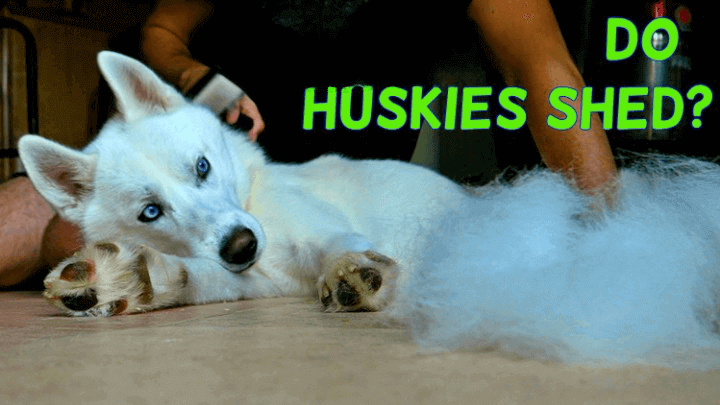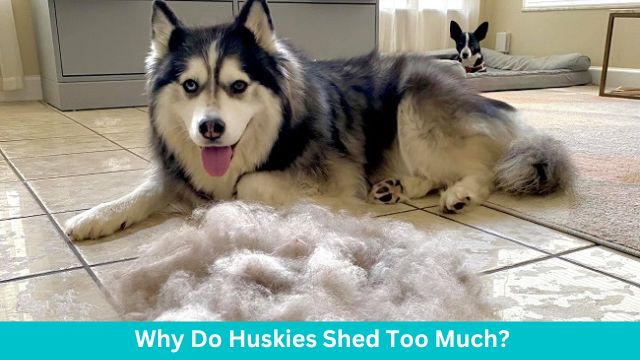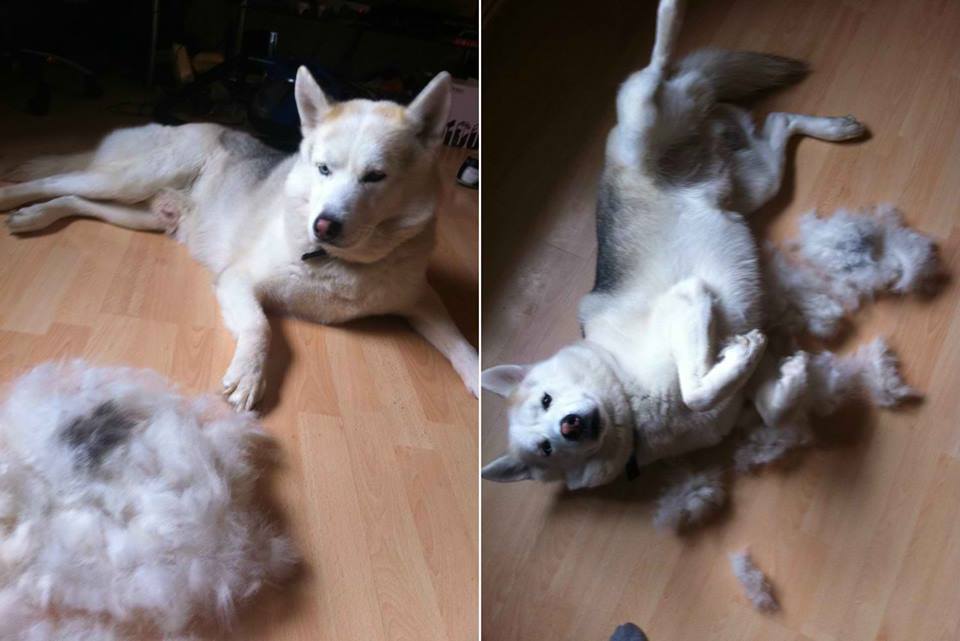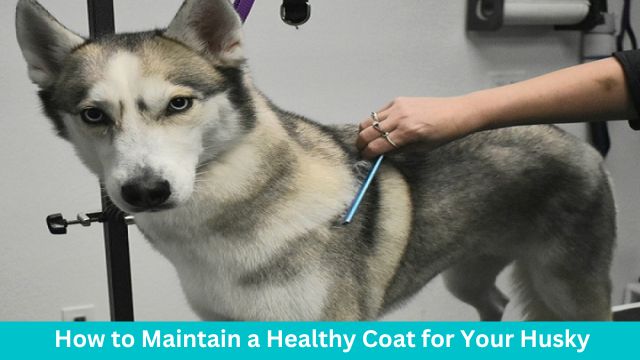Huskies, often known as the “Siberian husky” because of its origin in Siberia are the most loved dog breeds. You can easily identify them because of their thick double-coated fur, pointed ears, bushy tails and their sociable and loyal nature.
They are also playful and powerful, therefore a good choice for active dog owners especially those with kids. Just like any other dog breed, huskies too shed fur. This guide covers everything you would like to know about huskies shedding. Let’s dive in!
Do Huskies Shed?

So, you have got this beautiful friendly dog but one of the questions you would like to know is that “Do huskies shed?”
But first, we need to understand what shedding is. Well, this is when animals lose dead or damaged fur to make room for new and healthy fur to grow.
Back to our question, the answer is yes, just like other dogs, huskies do shed off their coat that protects them from the cold, also known as blowing their coat.
The unique thing about these breeds is that they shed once or twice a year only compared to other breeds that do it throughout the year because of seasonal changes.
It has been proven that most huskies will shed twice a year although some will only do it once a year, especially during spring as the weather gets warmer. It is therefore normal for the husky to shed, but it becomes a nightmare if your husky sheds off unusually.
So, if you are thinking of getting this stunning steady dog breed, you need to know what causes these beautiful dogs to excessively shed their coat abnormally.
Why Do Huskies Shed Too Much?

One thing you should be aware of before owning a husky is the fact that it is a thick double coated animal. This means that it has two layers of hair comprising an undercoat and a topcoat.
The undercoat is made of a layer of fine soft hair used for insulation during winter when they regrow and used for cooling during summer when they blow off or shed off while the top coat is harsh, wiry, and waterproof and obviously, protects the body of the husky from harsh environment and water.
For this reason, as the weather changes from hot to cold or the other way around expect the hair to fall off too much to fit the stipulated weather condition surrounding the husky.
They either have to shed and grow thinner undercoats during summer seasons or grow thicker, denser overcoats during winter when the weather is cold.
In other words, it is Mother Nature that determines when it is time for the husky to lose some hair or to grow it. But for some reason, the husky may shed off excessively which is frustrating and these could be the reasons why.
Causes of Abnormal Excessive Shedding in Huskies

So we are very aware that it is normal for huskies to shed to fit the seasonal change of their environment. However, abnormal shedding can take place.
These are some of the reasons why there may be excessive abnormal shedding in huskies.
- Nutritional imbalance
This is caused by feeding the dog an imbalanced diet especially when the food lacks protein which is essential for skin and hair growth.
2. Certain diseases
Some diseases may affect the husky’s skin and fur. Excessive hair loss in dogs could be an indicator of an underlying illness so you need to take it to the vet to find out the disease in time.
3. Skin parasite like flea and ticks
Parasites which irritate the dog’s skin force them to over-scratch, ending up losing its beautiful coat abnormally.
4. Skin allergies
Skin allergies may cause rashes, itching, and other skin reactions affecting the hair. It also makes the dog over-scratch.
5. Using the wrong shampoo
Some shampoos sold on the market are not good for either the skin of the dog or the hair itself. It may irritate the skin forcing the dog to over-scratch or break the hair hence over-shedding.
6. Stress at home
Biologically, it has been proven that animals lose hair when they are stressed and this is very true with a husky. According to Mayo Clinic, stress possibly causes the body’s immune system to attack hair follicles where the hair is rooted thus causing hair loss.
How to Stop Your Husky From Shedding
It is good that every problem has a solution, and these are some of the solutions to excessive shedding in huskies.
Vet visits: Regularly take your dog to the vet to check on its health especially when it feels irritated or it is over scratching to save both time and money.
Feed the dog a balanced diet: When you go out shopping for dog food, make sure to shop for food rich in protein especially chicken or fish. This is good for the skin and fur.
Introduce food supplements with Omega-3 oil: This has been proven to be very good for the skin of the dog. When the skin is fine, expect the dog to have good hair which will not abnormally break off.
Avoid using the wrong shampoo: Use deshedding shampoo that contains natural ingredients and avoid the ones that will burn the skin and the hair of the dog. Not all shampoos are good.
Don’t ever shave the hair from a dog: Instead, brush it regularly on a schedule. It is advisable to do this 2 to 3 times a week to reduce the dead skin on the dog.
Much as you are advised to brush your dog, take into consideration the type of brush you are to use when brushing your dog. Use an undercoat rake and slicker brush which don’t damage the hair of the husky.
Avoid over bathing: This is because it will risk drying the dog’s skin which will turn out not to be good for the hair conditioning of the dog.
Exercise the dog: This will keep the dog in shape and remember when you are in shape; it makes your body system work normally, and also works well for the dog. So go have fun walking your dog.
How to Maintain a Healthy Coat for Your Husky

Much as you don’t want your husky shedding off abnormally, wouldn’t you want to see its coat healthy and shiny? Well, here is how to maintain the cool coat of our husky.
a) Emphasize on protein diet
Always look out for food rich in protein as a primary ingredient. It is advisable to feed them lamb and chicken since they are rich in protein and make the hair glow.
b) Give the husky an Omega-rich diet and supplements
This has been proven to reduce dry skin and general irritation making our husky soft and beautiful. Give the husky some seafood, especially fish.
c) You are also advised to massage the coat with coconut oil
According to Jessica Smith, coconut oil is one of the best remedies for nourishing dehydrated skin and hair as well as preventing skin infection making the husky’s coat glow.
d) Bath, groom and brush your husky regularly
Use organic shampoo with natural ingredients to preserve the beautiful dog coat.
e) Pay attention to the environment in which your dog will stay or play
Make sure it is always clean. Also, make sure that the place your dog stays or plays is not infested with a parasite that will make its body itch.
f) Make sure to see the vet to check on the health of the dog to prevent diseases
Sometimes it is good to do a medical checkup on the dog to find out the problem that could affect its health, in this way you will be able to maintain a beautiful coat on your husky.
You may also like to read: Husky Lifespan – How Long Do Huskies Live
Frequently Asked Question
How long does a husky shed?
It normally takes 2 to 3 weeks for huskies to shed. However, some huskies may shed quickly or longer depending on the climate. As soon as your dog sheds, you need to observe to make sure it’s okay
When do huskies shed?
Huskies shed twice a year and this normally occurs during spring as the weather is getting warmer, and again in fall to make way for the growth of new undercoats for the cold weather ahead.
How much does a husky shed?
Huskies can shed a lot but there are times when they can shed excessively. This could be because of several factors but mostly because of health concerns.
Do huskies have hypoallergenic hair?
Huskies are not hypoallergenic. They shed all year round so it is not good for people with allergies.
Conclusion
Having a husky as a pet is great because of its loyalty, strong with a lot of stamina, and playfulness. They enjoy outdoor activities but are also independent so be rest assured of personal space just when you need it from your husky.
I hope this guide has given you a deeper understanding on huskies shedding and how to know abnormal shedding. You have also learned some tips on how to maintain a healthy coat for your husky.



